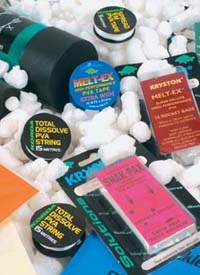PVA bags continue to be popular with today’s carp angler, but did you know there are many other uses for PVA other than just tying on a bag and chucking it out? We’ve got 20 of these uses for you, right here…
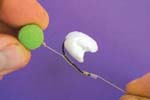 |
TIP ONE
Masking The Hook Point.1
This is a nice easy one – fold a piece of dissolving foam in half and bury the hook point into it. The foam will help the rig sink slowly and give a neat presentation. |
|
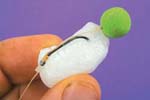 |
TIP TWO
Masking The Hook Point.2
Take one piece of dissolving foam and lay it horizontally to the hook, burying the hook bait into the foam. |
|
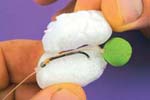 |
| Lick another piece of foam and stick it to the first piece so that they lay parallel to each other. |
|
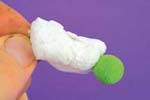 |
| This will take slightly longer to break down and so is a good tip when fishing in deep water. |
|
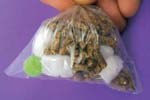 |
TIP THREE
Parachute Bag
When using PVA bags, put a few pieces of foam into the bag. This will help the bag land softly and, when the foam pops to the surface, you know your bag has melted properly. |
|
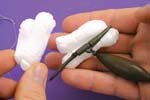 |
TIP FOUR
Rig Marker
Lick and stick several large pieces of foam around your lead core leader or lead clip. The foam, once it rises to the surface, will give an ideal marker to show where your bait is. You can then aim at the foam with a catapult or throwing stick and feed bait in the area of your rig. |
|
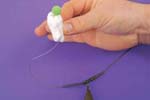 |
TIP FIVE
Weed Beater
By sticking several pieces of large nuggets of rig foam around the hook, you can guarantee a very slow descent of your bait. This is ideal as it keeps the rig above any weed and bottom debris for a long time and gives a perfect presentation every time. |
|
 |
TIP SIX
Super Stringer
Make a stringer by threading a few baits onto PVA tape or string with a baiting needle. |
|
 |
| The baits can be separated by inserting a piece of rig foam between each one. |
|
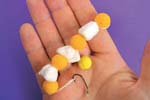 |
| This will give a slightly different spread to the baits compared to a standard stringer. |
|
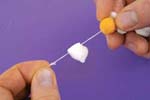 |
TIP SEVEN
No Knots
Instead of tying the PVA tape of your stringer to the hook and risking a blob of PVA being left to mask the hook point… |
|
 |
| …tie the stringer to a piece of foam and slip the foam onto the hook. |
|
 |
| The foam will melt quickly, leaving no residue on the hook at all. |
|
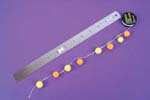 |
TIP EIGHT
Rising Bait
Take a 12-inch long strip of PVA tape or string and thread onto it a dozen or so baits, alternating between a bottom bait and then a pop-up and so on. When the string begins to melt, the pop-ups will rise to the surface and attract carp in mid-water to investigate. When they go down to the bottom they will find half-a-dozen nicely spread bottom baits… and your hook bait. |
|
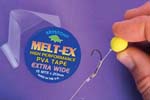 |
TIP NINE
As an alternative to using foam to protect the hook point, loosely wrap some wide PVA tape around the point and shank of the hook. |
|
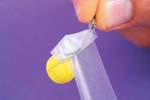 |
| As the rig descends through the weed, the tape protects the hook without making it buoyant. This is ideal when fishing in weed and not on top of it. |
|
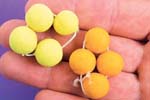 |
TIP TEN
It’s a stringer, but not as we know it!
Instead of the standard stringer presentation, which some carp may recognise as danger, try making a few mini stringers and tieing each one into a ring. |
|
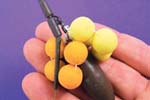 |
| The boilie rings can then be threaded onto your lead clip or hook, leaving a pile of baits once the string melts. |
|
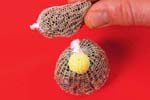 |
TIP ELEVEN
Small Is Beautiful
When using stocking-type PVA bags, make them compact and small and they will cast a lot further than the usual giant bags so many people seem to insist on using. Remember, the idea of a bag is to present a SMALL pile of attraction, not a meal. |
|
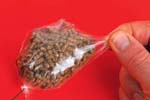 |
TIP TWELVE
Bomb ‘Em
When using solid PVA bags, fill them. Compact the bait in the bag, tie the bag off and lick and stick the corners of the bag to form a solid ball of bait. |
|
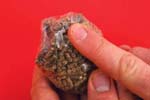 |
| This will cast well and make a thud when it hits the water – attracting carp on well-stocked waters to the spadoosh. |
|
 |
TIP THIRTEEN
Spread Bet
Try tying tiny bags with your chosen bait inside – this will take some practice as you want them as small as you can get them. These bags can then be cast or catapulted around the swim, depositing a spread of tiny piles of attraction. Carp will actively seek these piles of bait until they come across the one with your hook bait attached to it. |
|
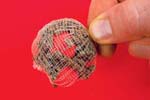 |
TIP FOURTEEN
Exploding Bags
Using stocking bags, tie them up as tight as you possibly can. |
|
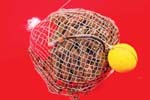 |
| When you think they are tight enough, make them tighter! When the bags dissolve, the tightly packed bait will explode out and form a good spread of attraction. |
|
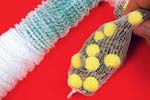 |
TIP FIFTEEN
Sag Bag
The opposite of the exploding bag can be used by under-filling a stocking and forming a saggy bag which… |
|
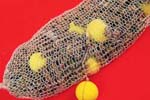 |
| … when melted, will leave a loose pile of bait that will not spread out |
|
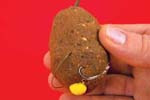 |
TIP SIXTEEN
Method Madness
When fishing the Method, one of the biggest problems is groundbait falling off the feeder in mid-flight. Solve this by tying a large PVA stocking bag around the ball of groundbait prior to casting. |
|
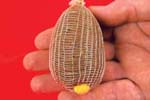 |
| This will keep the ball intact and won’t affect the aerodynamics when fishing at range. |
|
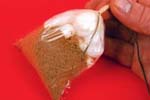 |
TIP SEVENTEEN
Softly, Softly
When casting to rolling fish, you can spook them with a heavy lead and bag hitting the water right over their heads. Using the lightest lead you have, fill a solid PVA bag with some light groundbait and put your rig inside it. Then, blow into the bag and place a few pieces of rig foam inside before tying it off. The bag will hit the water very softly, sitting on the top until the bag melts. The baited rig will then slowly descend towards the bottom and the feeding fish. This is also an effective method when feeding floaters at range in the summer. |
|
 |
TIP EIGHTEEN
Crash Bang Wallop!
The opposite of the soft-landing bag can be used when you need to send your rig through surface debris or thick weed. Use a very heavy lead and, after filling it, suck all the air out of the bag. This forms a dense and heavy bomb that will sink very quickly. |
|
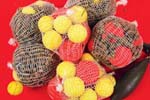 |
TIP NINETEEN
Casting Around
Instead of spodding, try making up lots of PVA bags of bait and, after casting your lead to your marker and clipping up, make a few casts with bags attached. This will slowly build the bait up in and around the area of your hook bait. |
|
 |
TIP TWENTY
Catty Bags
When you want to feed boilies and especially pellets to spots that you cannot quite reach with a catapult, make up some stocking PVA bags with your chosen bait inside. These bags will catapult out much further than loose feed and will allow you to bait up areas that you couldn’t previously reach without spodding. |
|

